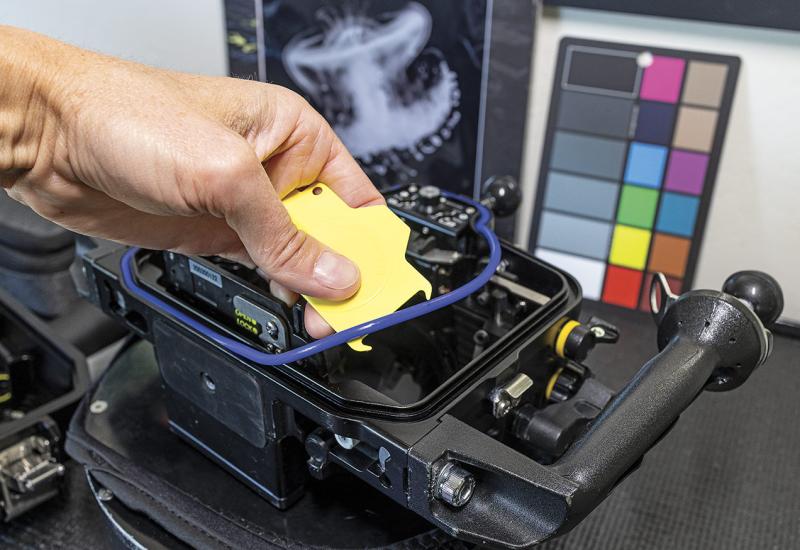Artist Spotlight: Rachel Brooks
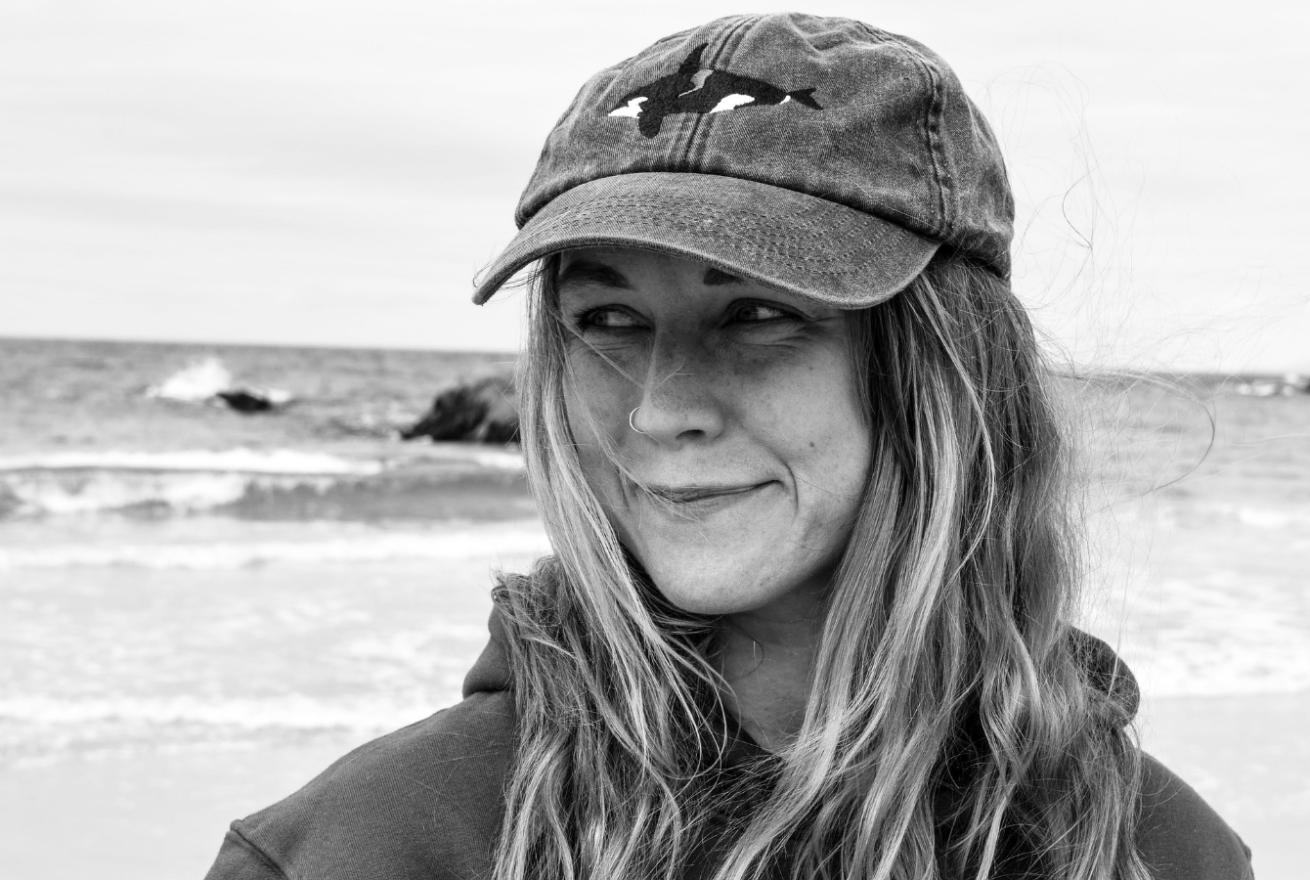
Courtesy Rachel BrooksPortrait of Rachel Brooks on the Isle of Coll in the Inner Hebrides, where she spends her summers looking for basking sharks.
Rachel Brooks is a scientific illustrator based in the Scottish Highlands. Her highly-detailed subject matter draws from her background in scuba diving and marine biology.
Inspired by her travels to the Great Barrier Reef, Ningaloo Reef and Lembeh Strait, Brooks’ intricate ink designs evoke the diversity of marine life around the world and the varied ecosystems that divers are able to explore with the state-of-the-art gear innovations displayed in our Gear of the Year feature.
We asked Brooks to take us behind the scenes to learn more about her process and inspirations behind her meaningful art.
Q: Where did your connection to the sea originate?
A: Growing up in the small town of Pennines, in Northern England, the sea was this exciting place that we visited on holidays. I have many memories of scouring the beach for shells, and peering into rock pools for crabs and all the hidden life that can be found there.
It wasn’t until I first worked on a research boat that I realised just how at home I felt on the water, and it’s that feeling that's kept me on the coast ever since. In 2020, I moved to Oban—in the Scottish Highlands—for an opportunity to work at sea in the Hebrides archipelago. I now work solely as an artist, using the inspiration from my time at sea, and my beautiful surroundings to create wildlife-inspired art.
Q: What is your background in the arts?
A: My journey to become an ocean artist was not a direct one, I always loved art and wildlife, and up until my college years, I was pretty certain I would study art at university. It wasn’t until a cetacean research project conducted a seminar at our school that my eyes opened to a whole new field.
I signed up to volunteer on the project in the Canary Islands over the summer, and spent weeks living amongst like-minded young people, taking sightings data and communicating with visitors from all over the world about whale and dolphin conservation. It may have been the first bite of the travel bug, spending time at sea and assisting with the research, but I decided this was what I wanted to be doing.
I switched my university application to Zoology, and after graduating spent eight years working in the ocean, teaching people to dive in some of the world’s most biodiverse reefs, guiding swims with charismatic megafauna and working with local communities, enabling them to use diving as a career and maintain their wonderful marine environment.
I returned home and started drawing some of my favorite species and sightings from that time, and Rachel Brooks Art was born from there!
Related Reading: Meet Scuba Diving Magazine's 2023 Photo Contest Winners
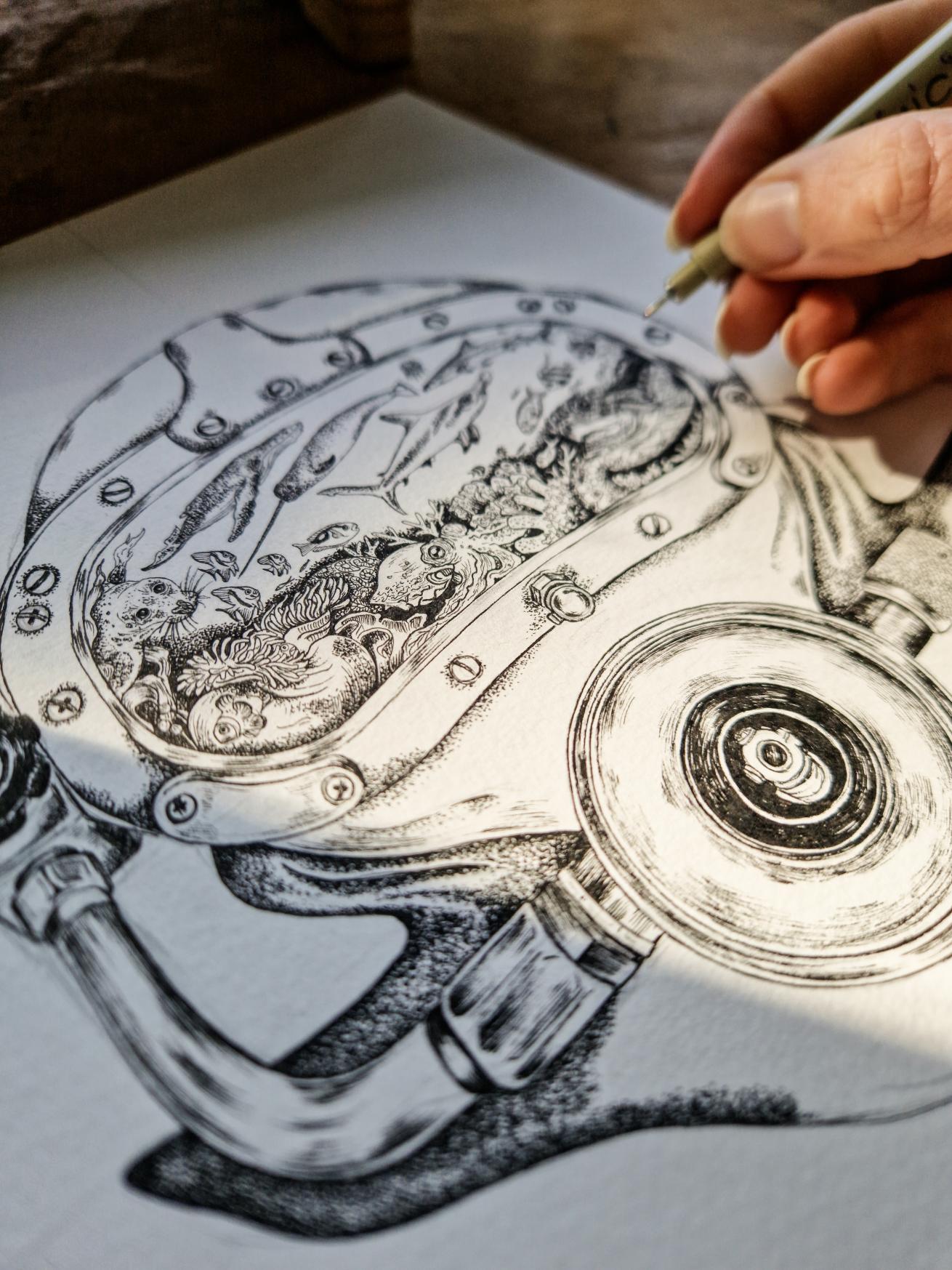
Courtesy Rachel BrooksA work in progress of a dive helmet with an ocean within, created using pointillism and line work in ink pens.
Q: How has being a scuba diver influenced your art?
A: Over the years, I have worked across the Indo-Pacific and Atlantic, with marine megafauna like whale sharks, basking sharks and mantas, and in the macro paradise of Lembeh Strait. I think spending so much dedicated observation time underwater has given me a closer perspective on the colors, textures and movements found in the ocean and a deeper connection to my subjects. It has also given me a deeper look at the problems our oceans are facing.
Everywhere I have dived, the Hebrides included, there is so much evidence of human activity and destruction. Our pristine beaches are littered with ghost fishing gear, the islands in Indonesia are suffocating in single-use plastics, and the precious corals I dived with in Australia are fading fast to warming sea temperatures. Seeing these things first-hand has really made me question my own impact and footprint on the planet, it makes me want to tread as gently as possible and encourage others to do the same. As much as my art celebrates the beauty of the ocean, I also want to portray the reality of what is happening to our seas and share these challenging issues.
Art is an excellent communication tool; it invites the viewer to think and evokes emotion.
Q: Do you spend a lot of time in the water in Scotland?
A: Absolutely—our marine life is beyond exciting! I don’t think people are aware of just how many species can be seen around the British Isles. Though there is undoubtedly more challenge to plunging into the brisk Atlantic waters, the kelp forests, seagrass meadows and spectacular marine life make it all the more worthwhile.
Over the past three years I’ve seen basking sharks, humpback whales and the last remaining orca of the West Coast Community. Not to mention the countless seals, sea birds, dolphins and beautiful underwater gardens. It’s a haven for ocean lovers and I feel so fortunate to have this on my doorstep.
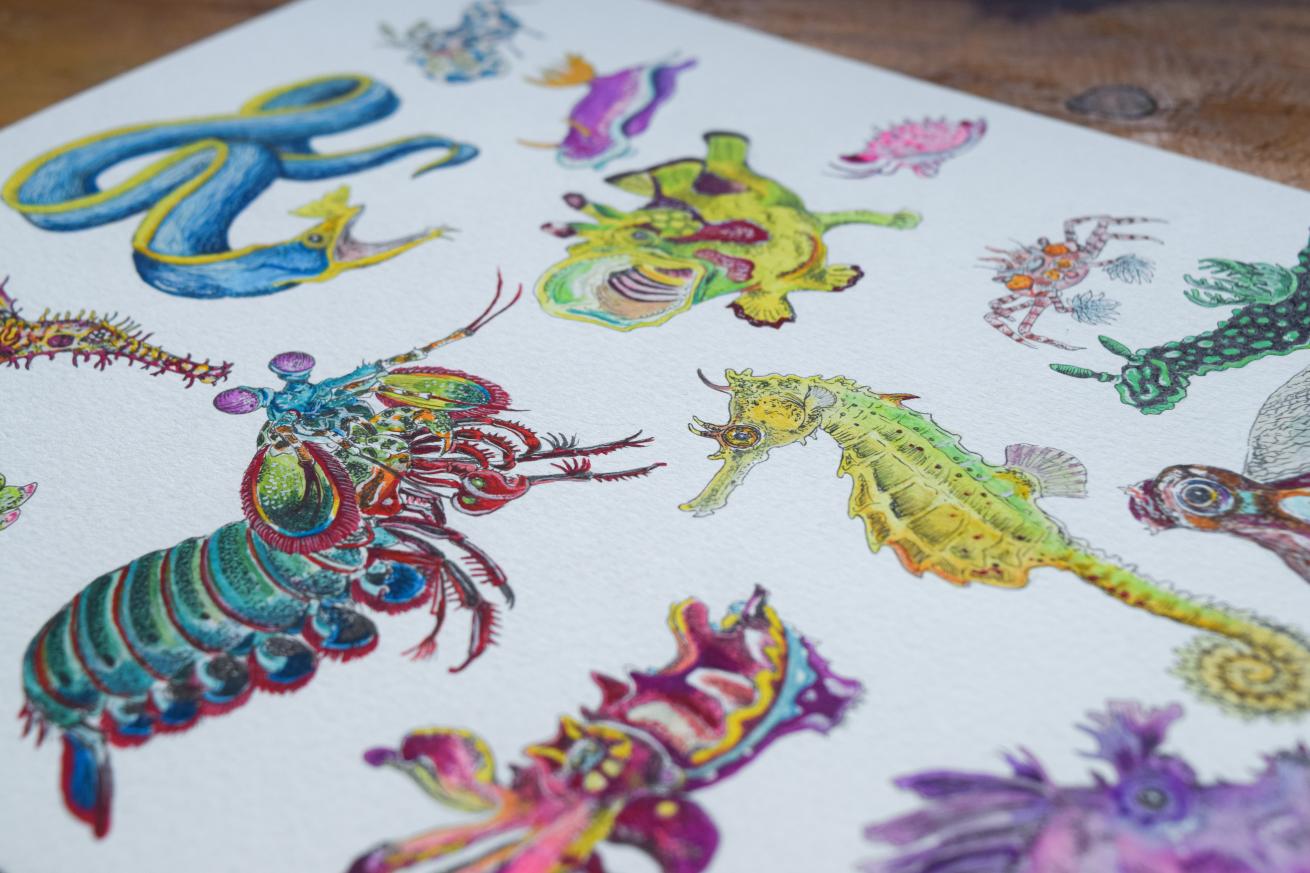
Courtesy Rachel BrooksA rainbow of critters inspired by the artist's time working in the Lembeh Strait, an original artwork created in ink and gouache.
Q: What experiences or subjects most inspire you?
A: I think what has inspired me most about the the marine world is the sheer amount of biodiversity to be found there, and there is still so much more to discover! One of my favourite places to dive was the Lembeh Strait, I managed a dive centre here for a year and was blown away by all the critters. I find muck diving so rewarding, searching the bottom for these rare creatures feels like a treasure hunt. The mandarinfish, frogfish and wunderpus could all have come straight from a children’s book.
Q: How did you come up with your unique style?
A: My background in zoology and working in the marine field has hugely influenced my style, I love the classic style of scientific illustration that I have seen throughout my life in guide books, university texts and field identification cards. I pay homage to this style whilst giving it a modern twist.
The other main style I work with is my intricate ink pieces that showcase whole ecosystems—my knowledge of ecology and biodiversity is the basis of these art works. I really wanted to pull the viewer in to reflect on the larger picture of how connected our natural world is.
Q: How do you believe art and conservation are connected?
A: I think art plays such an important role in storytelling, and immersing the viewer into another world. It captures the imagination and has the ability to expand reality into beautiful surrealists scenes, or thought provoking concepts. I think one of our biggest issues is how disconnected people are from the natural world.
As divers, we feel so connected to the ocean, and seeing first hand how special it is we want to protect it. Wildlife art celebrates the beauty of the natural world in the same way, and more conservation organisations are recognising its strength for public engagement.
I am currently partnering with the Shark Trust on a project called Oceanic 31, which celebrates 31 species of oceanic shark and ray created by 31 artists. I have contributed an A1 original basking shark drawing which is touring the country as an exhibition. The exhibition will not only raise funds for the ‘Big Shark Pledge’ but it is also celebrating the diversity of sharks and engaging new audiences with shark conservation.
Related Reading: 8 Breathtaking Underwater Images from Scuba Diving Magazine's 2023 Photo Contest
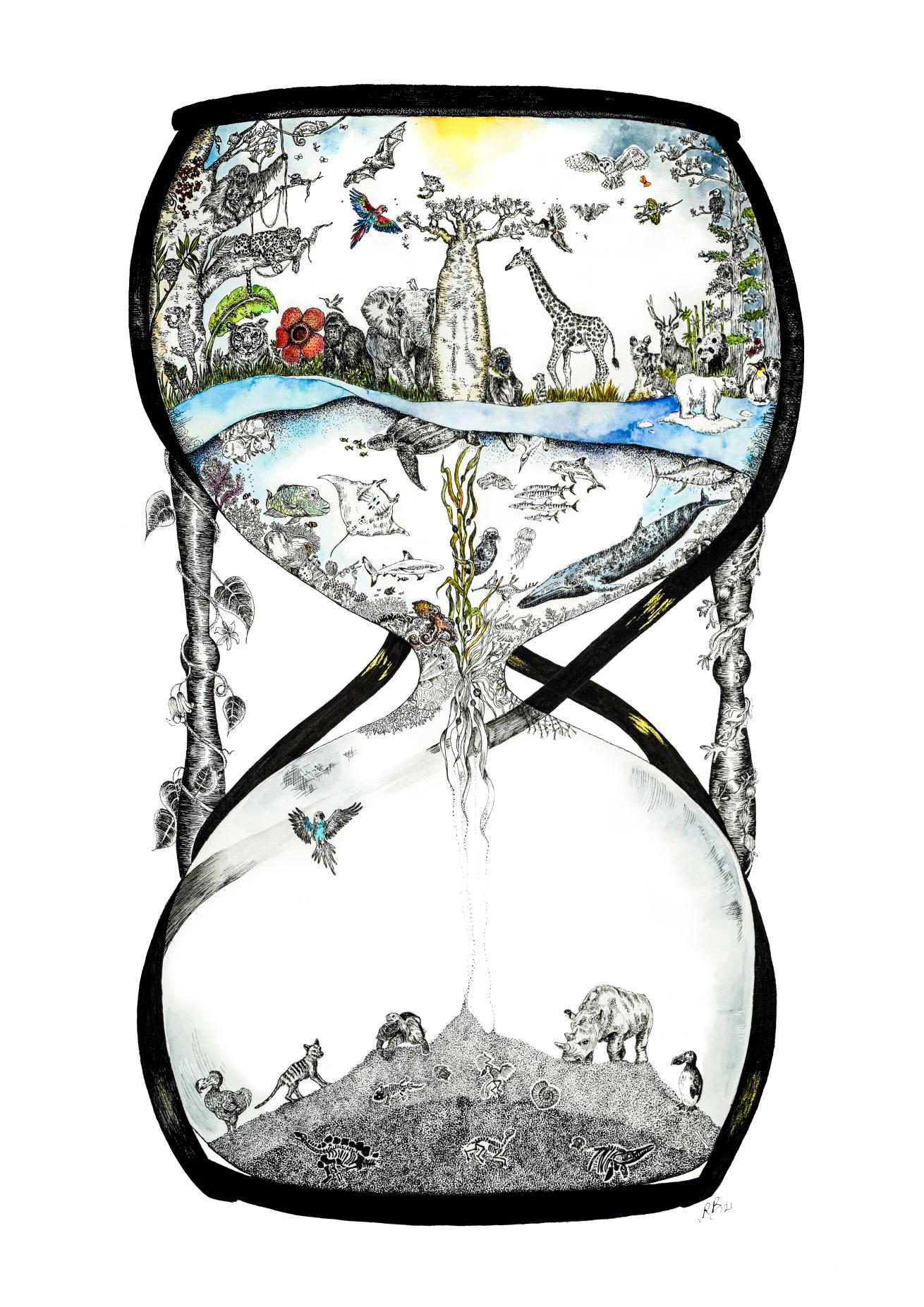
Courtesy Rachel BrooksThe Anthropocene, an artivism piece to reflect the unofficial epoch of time we are living in, where human influence has begun to significantly affect the environment.
Q: Do you aim to send a message through your work?
A: My mission is to showcase the natural world in its entirety, I want to celebrate the weird and the wonderful; all the quirky critters that play their own important role in our world. Working for eight years as a PADI Instructor I was able to introduce so many people to the underwater world, and see the excitement and joy in the eyes of my students when they took their first breaths in the ocean.
I still want to connect people to the sea, and for them to feel the magic of exploring beneath the waves. I hope my illustrations capture interest, because to have any hope to protect something we need to firstly know it is there, and secondly want to save it.
Q: How has your work in the field shaped your method of science communication?
A: Working in the marine field for most of the last decade has given me so much inspiration but also so much purpose to want to save these fragile habitats. I found communicating some of my experiences to be challenging. I was so passionate about it, and it was hard to put into words. I found art was a much more eloquent approach, and it has allowed me to reach so many people from around the world to form an amazing community of people who share a passion for the ocean.
I love to share new research and conservation successes in a way that is eye-catching and easy to digest, and make science more approachable to engage new audiences that otherwise may not have came across it. I find scientific illustration has been the perfect way to marry my two biggest passions. It has also given me so many incredible opportunities to collaborate with conservation organisations and scientists.




